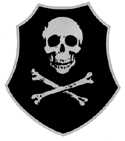Kuperjanov Battalion
| Kuperjanov Infantry Battalion | |
|---|---|
 Shoulder Sleeve Insignia of the Kuperjanov Battalion | |
| Active |
02.12.1918 – 21.06.1940[1] 09.03.1992 – present |
| Country | Estonia |
| Allegiance | Estonian Army |
| Branch | Infantry |
| Type | Line Infantry |
| Role | Infantry training |
| Size | One Battalion |
| Garrison/HQ | Võru, South-Estonia |
| Nickname | Partisans |
| Anniversaries | 23 December |
| Engagements |
|
| Commanders | |
| Current commander | MAJ Maidu Allikas[2] |
| Notable commanders | Lieutenant Julius Kuperjanov[3] |
| Insignia | |
| Distinctive Unit Insignia |
 |
The Kuperjanov Battalion (official name Kuperjanov Infantry Battalion, Estonian: Kuperjanovi jalaväepataljon) is an Estonian Army infantry battalion of the Estonian Defence Forces. The battalion has been previously known as the Kuperjanov's Partisan Battalion and as the Kuperjanov Single Infantry Battalion.
History
The Kuperjanov Infantry Battalion is an elite Estonian Army military unit which was established during the Estonian War of Independence on 23 December 1918 by the order of Colonel Ernst Limberg.[4] The commando type unit composed of volunteers was established after the Estonian Provisional government call for volunteers to the Estonian National Army.
During the War of Independence
Julius Kuperjanov had been a school teacher who was commissioned in the Imperial Russian Army. In 1918 he joined Estonian forces at the start of the War of Independence. In December 1918 he received permission to raise a ranger battalion. School students were among the first recruits of the Tartumaa (that is, Tartu County) Partisan Battalion, which was formed at Puurmani manor. Due to a flow of young, but highly motivated volunteers, Kuperjanov's unit became an independent battalion known for its high morale and daring tactics. The battalion played a crucial role in liberating the southern part of Estonia.
After the death of Julius Kuperjanov on 2 February 1919 from wounds received at the manor of Paju, the battalion was officially named Julius Kuperjanov Partisan Battalion by the Commander in Chief of the Estonian Defence Forces General Johan Laidoner. In 1919 Kuperjanov's Battalion had a central part in destroying the imperialist German Landeswehr Army and liberating Latvia. After victory in the War of Liberation and the Landeswehr War, the Kuperjanov Battalion acted as part of the peacetime Estonian Defence Forces.
During the Soviet occupation
The battalion was disbanded in 1940 after the Soviet occupation. The Kuperjanov Battalion was re-established on 9 March 1992 as the Kuperjanov Independent Infantry Battalion after Estonia regained its independence from the Soviet Union.[5]
Present day
The Kuperjanov Infantry Battalion is based in Võru in southeast Estonia and is now one of the largest battalions inside the armed forces of Estonia. It is known for high demands from its recruits and officers and a special esprit de corps uniting its members in service and in reserve.
After the Estonian Ministry of Defence army reform the unit was transformed into an infantry training facility. During the last few years, the development and renovation of the Kuperjanov Battalion’s infrastructure has been completed. The main concern of the unit now is the establishment of the Nursipalu training area which is necessary for high-quality training.
Structure
- Headquarters[6]
- 1. Training company (õppekompanii)
- 2. Training company
- 3. Training company
- 4. Training company
- 5. Training company
- 6. Training company
- Staff and support centre
References
- ↑ http://en.wikipedia.org/wiki/History_of_Estonia#Soviet_Occupation
- ↑ Eesti Kaitsevägi – Toomas Möls
- ↑ Eesti Vabadussõda
- ↑ Miljan, Toivo (2004). Historical Dictionary of Estonia. Scarecrow Press. p. 494. ISBN 0-8108-4904-6.
- ↑ Eesti Kaitsevägi:Kuperjanovi Üksik-jalaväepataljon
- ↑ https://www.riigiteataja.ee/akt/13352429
External links
See also
- Special Forces train in Baltics
- Estonian Defence Forces
| ||||||||||||||||||||||||||||||||||||||||||||||||||||||||||||||||||||||||||||||||||||||||||||||||||||||||||||||||||
| |||||||||